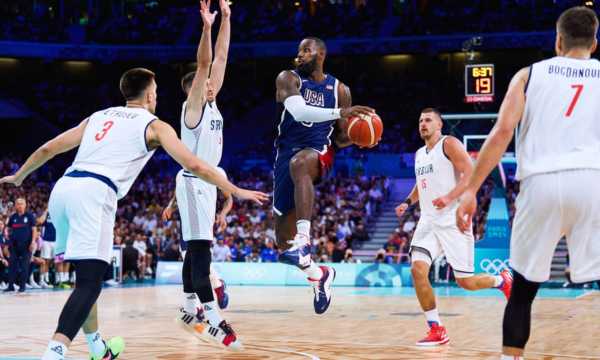The Different Types of Basketball You Need to Know
Discover the different types of basketball and how they turn the sport into a unique experience, whether you’re playing or watching!
Ad
Did you know basketball goes far beyond the traditional five-on-five game?
From the classic NBA format to intense street court matchups, each variation offers a different kind of thrill.
Today, we’ll explore all the formats that make basketball one of the most versatile and accessible sports in the world.
Get ready to find out which style suits you best!
5×5 Basketball: The Global Classic
5×5 basketball is the most traditional format globally.

Format 5×5 Basketball (Google Source)
Played on a full court with five players on each team, this version is the standard in top-level competitions like the NBA, EuroLeague, and the Olympics.
Games are played in four quarters, with time duration varying by league—12 minutes in the NBA and 10 minutes under FIBA rules.
Among all types of basketball, 5×5 stands out for its tactical complexity and the diversity of player roles.
The players orchestrate the offense, while forwards and centers play critical roles on both ends of the court.
This format values both team play and individual brilliance capable of turning games around.
It demands intense physical preparation, with increasingly versatile athletes capable of playing multiple positions.
Modern 5×5 basketball tends to favor taller players with shooting and ball-handling skills once reserved for guards.
3×3 Basketball: Olympic Speed on Half Court
3×3 basketball revolutionized the sport by becoming the first urban variation to earn Olympic status at the Tokyo 2020 Games.
Played on a half court with just three players per team, this format is known for its impressive speed.
Its intensity makes 3×3 a non-stop spectacle where every second matters.
Among all official types of basketball, 3×3 has its own set of rules to speed up the game:
- 12 seconds to shoot.
- With games decided either by time limit (10 minutes) or score limit (21 points).
- Quick throws are worth 1 and 2 points instead of 2 and 3.
FIBA hosts a world tour circuit for 3×3 basketball that has drawn players who specialize in the format.
Its dynamic nature demands well-rounded athletes who can both defend and attack effectively.
This variation values versatility and physical endurance, making it attractive for both players and fans.
Streetball: Urban Culture and Creative Dribbling
Streetball is the most free-form expression of basketball, emerging from the urban culture of major American cities.

Format Streetball (Google Source)
Unlike regulated forms of the game, streetball values creativity and flair over formal rules.
Dazzling dribbling moves—known as “handles”—are the trademark of this format, blending sport with artistic expression.
Public courts are places where communities come together to play. The rules can vary from one place to another, with phrases like “the winner stays” and “make it, take it” being common.
Tournaments like the AND1 Mixtape Tour helped popularize this version, highlighting players with flashy skills who might not stand out in traditional basketball.
Streetball’s influence is visible across professional leagues worldwide, as NBA players often borrow moves born on outdoor courts.
Wheelchair Basketball: Skill on Wheels
Wheelchair basketball is one of the most thrilling and technically challenging forms of basketball.
A Paralympic sport since 1960, it retains the essence of traditional basketball with rule adaptations that showcase the skill and power of the athletes.
Rules are similar to standard basketball with slight modifications, such as the “two pushes” rule—players must dribble the ball after two wheelchair pushes.
Among all adaptive versions of basketball, wheelchair basketball enjoys the widest global visibility, with professional leagues in numerous countries.
Sport-specific wheelchairs are lightweight and agile, allowing for fast-paced gameplay.
Players are assigned a functional classification from 1.0 to 4.5 based on mobility, and each team must stay within a total point limit on the floor.
Court size and rim height are the same as in the traditional game. This format requires exceptional upper-body coordination and chair control, making it every bit as technical as other variations.
Mini Basketball: Introducing the Future Stars
Mini basketball is a form specially adapted to introduce children aged 6 to 12 to the sport.
It modifies key aspects of the game to make it accessible for young athletes. Basket height is reduced to 2.60 m (8.5 feet), and a smaller, lighter ball is used.
Among developmental basketball formats, mini basketball focuses on fun and fundamentals without early position specialization.
Rules are simplified and more forgiving, encouraging participation and progressive learning.
Periods last around 6 to 8 minutes, and court dimensions are reduced accordingly.
The format is often divided by age group: under-8, under-10, and under-12, with specific adaptations for each.
FIBA recognizes mini basketball as essential to the global growth of the sport and promotes international events to support it.
Many professional stars started their journey on mini basketball courts.
Where to Find and Follow Different Basketball Formats
Professional 5×5 basketball is widely available on TV and streaming services, with the NBA being the most popular global league.
For 3×3, the FIBA 3×3 World Tour and Olympic tournaments offer high-level content available on YouTube and FIBA’s social channels.
Among alternative types of basketball, streetball has a strong presence on platforms like YouTube, where specialized channels showcase jaw-dropping highlights from courts around the world.
Wheelchair basketball gains visibility during the Paralympic Games and through national leagues that are getting more media coverage.
For those looking to play, apps like Meetup and social groups help connect players interested in different formats near their location.
Many cities have amateur leagues that include all types of basketball, offering competitive opportunities for players of all levels.
What Do You Need to Start Playing Basketball?
Starting to play any types of basketball requires minimal equipment, making the sport widely accessible.
- For 5×5 or 3×3 basketball, you’ll basically need a ball that fits your hand size and basketball shoes with good cushioning and grip.
- Among all types, streetball is the most accessible—just find a public court with a hoop.
- For wheelchair basketball, the initial investment is higher due to specialized equipment, but many programs offer chairs for beginners.
- Mini basketball requires lower hoops and smaller balls, widely available in schools and social programs.
Regardless of the type of basketball you choose, developing basic fundamentals is essential: dribbling, passing, shooting, defensive positioning, and spatial awareness.
Training opportunities vary by region—schools, clubs, community programs are great places to get started.
Comparing Speed, Rules, and Styles
Examining the various types of basketball reveals how each format emphasizes different aspects of the sport.
- Traditional 5×5 basketball balances strategy and individual talent in a more controlled pace with frequent stoppages.
- 3×3 basketball prioritizes speed and versatility, with few breaks and quick decision-making.
- Among all official formats, 3×3 is the fastest, with average games lasting just 10 minutes.
- Streetball emphasizes self-expression and dribbling skills in an unstructured environment.
- Wheelchair basketball sticks closely to 5×5 format rules with specific adaptations, while mini basketball simplifies everything for learning.
Below, see a comparative table illustrating the differences between each type of basketball:
Quick Comparison Table
| Format | Players | Game Time | Main Style |
| 5×5 | 5 per team | 40–48 minutes | Strategic |
| 3×3 | 3 per team | 10 minutes | Fast |
| Streetball | Variable | Score-based | Creative |
| Wheelchair | 5 per team | 40 minutes | Technical |
| Mini | 5 per team | 24–32 minutes | Educational |
Final Thoughts
Exploring the many types of basketball shows how the sport has evolved to suit various publics, needs, and contexts.
From the classic 5×5 to dynamic 3×3, from expressive streetball to the inspiring intensity of wheelchair basketball, each format offers a unique experience.
Understanding the differences between types of basketball enriches our appreciation of the game and opens up new ways to experience it.
What’s most fascinating is how these formats influence one another, with innovations born on the streets making their way to professional courts.
So, which type of basketball is right for you? The answer might define your next sporting admiration!
FAQ
1. Which basketball type is best for beginners?
2. Can players switch between different types of basketball?
3. Can I play streetball without prior experience?
4. Is there an age limit to start any type of basketball?
 Watch Live Basketball: Best Streaming Apps
Watch Live Basketball: Best Streaming Apps
Remember when catching a game meant rearranging your entire evening around cable schedules? Live basketball streaming changed that forever. Ad Today, you can watch live basketball […]
Keep reading NBA Fantasy: Best Apps to Build and Manage Your Champion Team
NBA Fantasy: Best Apps to Build and Manage Your Champion Team
NBA fantasy turns real games into a strategic, data-driven adventure where you manage a roster, make smart moves, and enjoy friendly competition. Ad In this article, […]
Keep reading NBA App: Watch Live Games & Highlights
NBA App: Watch Live Games & Highlights
The NBA App has evolved into a powerful hub for fans seeking live action, quick highlights, and original stories that bring the league closer than ever. […]
Keep reading